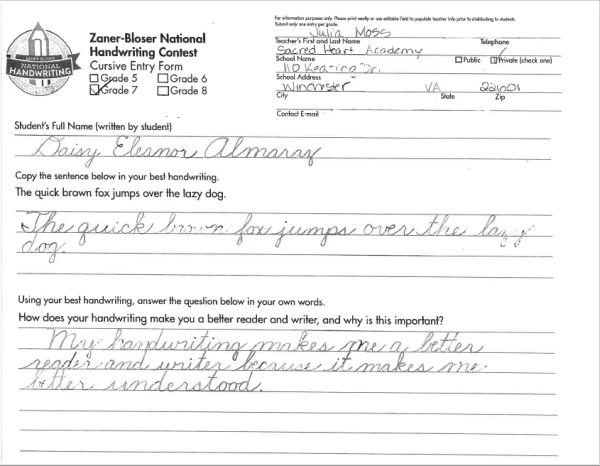Boston, Mass., Jun 24, 2023 / 08:00 am
“The quick brown fox jumps over the lazy dog” is the sentence that won Daisy Almaraz, a Catholic school seventh grader in the Diocese of Arlington, Virginia, a national competition.
The sentence doesn’t contain any special alliteration or a readable rhyme scheme. But it does contain every letter of the alphabet.
For a national cursive handwriting competition, the judges wanted to see if the students were up to the task of gracefully writing every letter of the alphabet from A to Z.
“Excited” and “surprised” were the words that Almaraz used to describe her reaction when she found out that she was one of nine national winners among about 80,000 entries in the 2023 Zaner-Bloser National Handwriting Contest, which students at her school, Sacred Heart Academy in Winchester, Virginia, partake in each year.
Julia Moss, Almaraz’s seventh grade literature teacher, told CNA Friday that she was “amazed” and “excited” that one of her students won the national competition.
Moss said that students from the school had won on the state level in prior years and was expecting an awards email to inform her that Almaraz was a semifinalist.
“And I kept reading the email I said, ‘Oh, my goodness, this is the top!’”
“So it was phenomenal,” she said.
Zaner-Bloser, an education publisher dedicated to supporting teachers and students, awards a cash prize and educational materials to students and schools that won awards.
Each Grand National Champion receives a large trophy as well.

Almaraz, who won the state competition as a sixth grader last year, said she likes handwriting because “the neater your handwriting looks, the more people are going to connect with your writing.”
“So, I feel like it makes me better understood,” she added.
If someone wants to work on their handwriting in cursive, they shouldn’t rush, Almaraz said.
“Your handwriting definitely looks better when you take your time and focus on how you hold your pencil,” she added.
Almaraz prefers writing with a pen because it “flows better” and cursive writing requires continuous pen-to-paper contact.
(Story continues below)
Moss said that writing in cursive can communicate something to the reader other than the meaning of the words on the page.
She said that if the writing is poorly written or scrawled it can send a message that something is “out of place.”
Moss also said that learning cursive can be helpful for reading historical documents.
Founding American documents such as the Declaration of Independence, the Bill of Rights, and the Constitution are all written in cursive.
Many jurisdictions have dropped cursive from their curriculums, Moss said, adding that Catholic schools have, in her experience, prioritized it.
According to the National Education Association, only 21 states require cursive to be taught in public schools.






